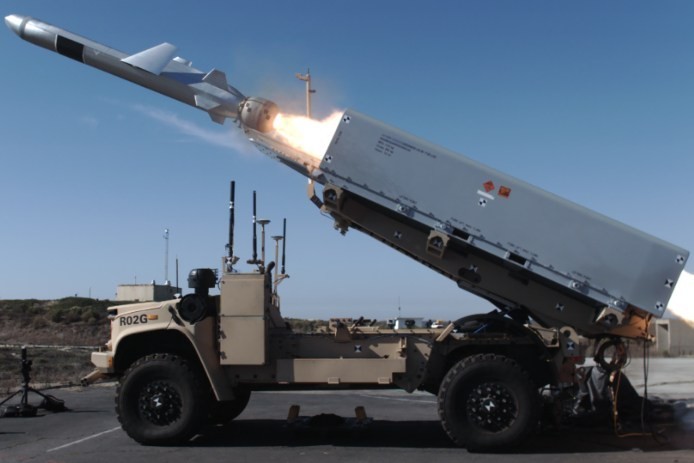Oshkosh Defense LLC, of Oshkosh, Wisconsin, is awarded a $23,709,168 contract for the procurement of Remotely Operated Ground Unit for Expeditionary Fires (ROGUE-Fires) carriers for use in the Navy/Marine Expeditionary Ship Interdiction System (NMESIS). NMESIS is a land-based missile launcher platform that provides the Marine Corps High Mobility Artillery Rocket System battalions and operating forces with anti-ship capabilities. NMESIS integrates a Naval Strike Missile (NSM) launcher unit, capable of launching two NSMs, onto a ROGUE-Fires carrier. NMESIS makes extensive use of proven sub-systems, such as the Oshkosh Joint Light Tactical Vehicle (JLTV) chassis. Work is expected to be completed in November 2023. Marine Corps Systems Command, Program Manager Long Range Fires, Quantico, Virginia, is the contracting activity.

The U.S. Marine Corps wants to be able to sink ships, and it wants that ability fast. NMESIS is envisioned to provide anti-ship fires from land as part of an integrated naval anti-surface warfare campaign. The Marine Corps’ GBASM solution consists of an unmanned JLTV-based mobile launch platform, called the Remotely Operated Ground Unit for Expeditionary Fires (ROGUE-Fires), and the Naval Strike Missile (NSM). The NSM is the same missile used by the navy for the over the horizon weapon system deployed on littoral combat ships. The Naval Strike Missile (NSM) is an anti-ship and land-attack missile developed by the Norwegian company Kongsberg Defence & Aerospace (KDA). Part of the move will be to give Marines their own ability to take on enemy ships. As the Marine Corps reorganizes to prepare for a potential conflict with China, the service is considering three new Marine Littoral Regiments (MLR).

The U.S. Marine Corps asked for 29 of the Norwegian-designed NSMs in the initial budget request and the additional unfunded ask would bring the total to 64 to outfit the service’s first operational, Navy-Marine Corps Expeditionary Ship Interdiction System (NMESIS) equipped with a medium-range missile (MMSL) battery by Fiscal Year 2024. NMESIS could create a no-go zone for enemy ships until friendly forces return. NMESIS consists of two NSMs and a launcher/weapon control system integrated onto a ground-based, remotely operated carrier (called ROGUE-Fires). Alternately, NMESIS could defend beachheads from enemy naval attack. It will provide a ground-based anti-access/area denial, anti-ship capability. This quantity would provide two combat loads for Marine Corps MMSL batteries.

The Marine Corps’ top modernization priority is fulfilling the requirement for a ground-based anti-ship missile capability. The operational requirement for this ship-killing capability is a relatively new development stemming from the Commandant’s Planning Guidance and the Corps’ Force Design 2030 efforts. When integrated into sensor and communication networks supporting a naval or maritime kill chain and synchronized with the employment of other missile systems, the Marine Corps’ medium-range missile battery will serve as a component of the Naval expeditionary force’s stand-in force in support of the naval sea control effort. In two years, the Long Range Fires program office at MCSC has acquired Navy/Marine Corps Expeditionary Ship Interdiction System (NMESIS), an anti-ship missile capability meeting the GBASM requirement.













